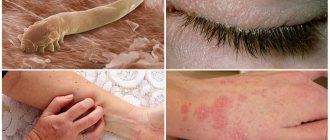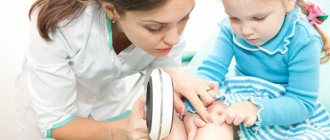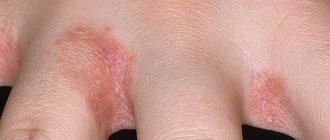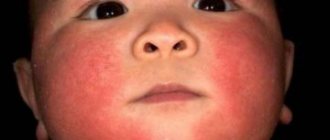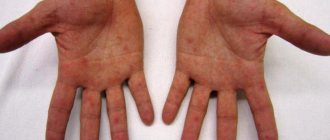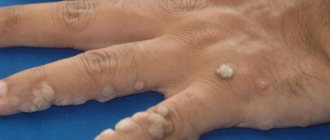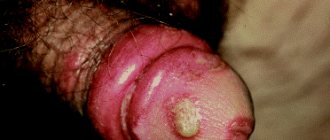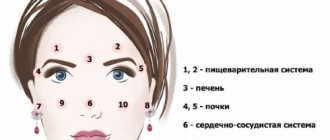(average: 0.00 out of 5)
Erythema is an unusual redness of the skin caused by increased blood flow to the superficial skin capillaries.
In 7-8 cases out of 10, newborns may have physiological erythema. In this case, redness can spread both throughout the body and only to the baby’s arms and legs. Since in full-term newborns with physiological erythema, redness usually does not appear immediately, but several days after birth, inexperienced parents are often frightened at the sight of a suddenly reddened child, although most often this frightening symptom hides a completely harmless physiological erythema of newborns (an alternative name is physiological catarrh skin).
Pediatricians around the world are still arguing whether this type of erythema can be considered a disease - after all, this is a normal condition of a baby, which goes away on its own within a week, as the baby adapts to the environment. The category of diseases includes toxic erythema, similar in external signs - this is a pathological condition of a child, signaling a certain problem in his body.
An alarming signal is not the presence of simple erythema of newborns, but its absence: in some cases this may be associated with serious pathologies of the baby’s development (presence of intrauterine infection, collapsed lung, intracranial hemorrhage).
Top
First symptoms of the disease
What signs can be used to determine that a person has erythema? The photo clearly demonstrates them. Basically, the redness of a person’s palms has a symmetrical shape. And the rashes themselves resemble a finely spotted or dotted pattern. The places where the rash appears are the palms and, in rare cases, the feet. As described above, this condition manifests itself in chronic liver diseases. Sometimes the symptom of this disease can be observed in pregnant women.
As a rule, in addition to redness of the palms, the patient exhibits severe fatigue, general weakness of the whole body, and low temperature. People who have liver problems become irritable and may experience severe headaches, trouble sleeping, and excessive sweating.
What does the pathology look like?
Distinctive signs of the syndrome can be seen in the photo. The reddened areas are usually symmetrical. Redness looks like small spots or dots and is localized on the palms and soles. When pressed, they temporarily disappear, but pain may appear. At the site of redness, vessels diverging in different directions, shaped like “stars,” sometimes appear. In some cases, the skin may itch.
Associated symptoms associated with liver disease:
- Itching of the skin, characteristic of cholestatic syndrome. The sensation can be periodic or constant, localized both on the palms and soles, and on other parts of the body.
- The patient's skin turns yellow. This symptom is explained by an increase in the level of bilirubin in the blood. The appearance of jaundice in a patient is usually associated with the presence of viral or cholestatic hepatitis in a chronic form.
- Hemorrhages (purpuras) on the skin and mucous membranes, also called hemorrhagic syndrome. A distinctive feature of purpura is that it does not disappear with pressure. May be small or large (resembling a bruise).
- In the presence of chronic liver pathologies, the tongue swells and turns red. If the patient suffers from liver failure, then the surface of the tongue, lips and mucous membranes becomes dark red, and sometimes even acquires a purple tint .
- Due to liver disease, an allergic form of dermatitis occurs. Distinctive features are bright red spots on the skin.
- Asthenovegetative syndrome is a general deterioration in the patient’s well-being. The temperature rises, weakness appears, appetite worsens, poor sleep. The patient sweats heavily, becomes nervous and irritable.
Palmar erythema in children
In most cases, erythema in children indicates the development of hepatitis. Basically, this disease begins gradually. Signs of the emerging disease may initially be systemic or hepatic. But with the further development of this disease, both groups will begin to appear.
Systemic symptoms include the following:
- skin rash;
- fever;
- arthralgia.
Liver symptoms include the following:
- pain under the ribs, which tends to increase;
- palmar erythema is manifested by the appearance of spider veins;
- enlarged liver and spleen;
- increased body temperature;
- headache;
- severe fatigue.
As a rule, liver signs are usually the first to appear in a child. Therefore, if at least one of the above symptoms appears, parents should seek help from a specialist as quickly as possible. Do not forget that in children, hepatitis can quickly take on a chronic form, with exacerbations occurring a couple of times a year.
Cause and pathogenesis
As mentioned earlier, “liver signs” (including erythema) that appear on human skin are a consequence of developed hepatocellular failure. That is, the liver becomes unable to fully perform its basic functions. In particular, the process of utilization of “spent” hormones is disrupted, among which estrogens occupy a special place.
The resulting hyperestrogenemia has a systemic effect on the body, especially on the vascular wall, causing dilatation of capillaries, promoting the opening of arteriovenous shunts (the area where the arterial and venous beds connect). This, in turn, leads to blood flow to the periphery. Hence the redness (erythema) of the palms and the formation of telangiectasia (or, more simply, spider veins).
But it is worth saying that estrogen levels can be elevated under other circumstances, especially when it comes to women. Thus, pregnancy, various tumor processes in the ovaries, menopause, hormonal dysfunctions in females can be accompanied by hyperestrogenemia (and, as a result, erythema). Therefore, this symptom is diagnostically significant only in combination with other signs of damage to a particular organ.
Thus, palmar erythema can accompany the following physiological conditions and diseases:
- Pregnancy.
- Polycystic ovary syndrome.
- Hormonally active ovarian tumors.
- Menstrual irregularities.
- Cirrhosis of the liver.
- Obesity.
- Chronic renal failure.
- Aromatase overactivity syndrome.
- Hereditary pathologies (Lane's disease).
Treatment of the disease
Palmar erythema itself is not curable. Only the reason why it appeared is eliminated. Therefore, therapy involves ridding a person of the main ailment, which served as a provocateur. And since erythema is a sign of liver disease, this organ is treated accordingly.
After diagnosing and establishing the true cause, the specialist prescribes adequate therapy for this disease. It is important to understand that its duration directly depends on how promptly the patient sought help. If a lot of time has been lost, the treatment process will drag on for a long time and will be carried out directly in the hospital.
As for getting rid of the rash, your doctor may recommend following the following rules:
- if necessary, bed rest should be observed;
- mandatory exercise prescribed by the attending physician;
- strict adherence to diet;
- Minimize the consumption of foods that cause an allergic reaction.
- completely get rid of all bad habits.
Diagnostics
The diagnostic search consists of identifying pathologies in the patient that accompany palmar erythema. After a thorough history and physical examination, the doctor determines additional research methods to clarify the preliminary diagnosis.
First of all, it is necessary to exclude liver pathology. To do this:
- Complete blood count (evaluate the level of red blood cells, platelets, leukocytes and lymphocytes, hemoglobin, exclude hypersplenism syndrome).
- Biochemical blood test (they study the activity of transaminases - specific enzymes that are found mainly in hepatocytes, which means that when they are destroyed, they increase their activity; evaluate the level of protein - protein synthetic function of the liver; the level of bilirubin and its fractions, cholesterol, alkaline phosphatase, GGTP, etc.) .
- General analysis of urine and feces (color, level of urobilin and stercobilin).
- Ultrasound of the abdominal organs.
- CT or MRI (if indicated).
Traditional methods of treatment
Erythema may go away faster if mistletoe tincture is taken along with medications. To prepare, you will need 10 g of mistletoe fruits, which need to be crushed. The fruits are poured with 500 ml of pure alcohol. Leave the remedy for about a month. After the end of the period, the tincture is taken diluted with water. You need to dilute 35 drops with water and drink once a day.
If a person decides to treat liver diseases with the help of traditional medicine, then he should definitely consult a doctor first. Traditional methods quite often give positive results, but in order to avoid possible complications, it is still worth getting a consultation. We must not forget that the attending physician must know about all the drugs used by a person. This will help in case of complications.
Conservative medicine in the treatment of fixed erythema
The main principle of treatment is the elimination of the drug or irritant factor. Therapeutic treatment is indicated when the disease becomes severe and consists of the following:
- Use of desensitizing agents. In clinical practice, sodium thiosulfate solution is used for intravenous administration.
- Carrying out plasmapheresis and hemosorption procedures;
- For severe itching, sedatives are prescribed. Diuretics are taken to remove toxins.
- Activated carbon is indicated as a sorbent. To normalize the functioning of the gastrointestinal tract, enzyme-containing drugs and eubiotics are prescribed.
- In mild cases, topical medications containing corticosteroids are prescribed. In complicated cases of the disease, hormonal drugs are prescribed orally. Intravenously or intramuscularly.
An important component of the course of treatment is a diet in which chocolate, citrus fruits, smoked, fatty, and pickled foods are excluded from the diet.
diagnosing
Blood tests are not needed to diagnose erythema multiforme, which doctors can usually identify by looking at the rash.
Sometimes a skin biopsy may be needed to rule out other diseases. To do this, the doctor takes a small sample of skin from the affected area and sends it to a laboratory for analysis.
Doctors may do a chest X-ray if they suspect Mycoplasma pneumoniae is the cause.
People sometimes confuse erythema multiforme with Stevens-Johnson syndrome or toxic epidermal necrolysis because these types of skin reactions have similar symptoms.
Stages
- Erythema multiforme minor: practically it affects only skin with typical lesions of a symmetrical acral location. Mucosal involvement is rare and when present it is mild and affects a single mucosa, often the oral cavity.
- Erythema multiforme major: Skin lesions are more extensive, but do not exceed 10% of the body surface area. Typical target lesions are present. Mucosal involvement is severe and affects at least two different mucosal sites; The oral mucosa is usually affected.
Lyme disease
One type of erythema migrans that is most common in mid-latitudes is Lyme disease. It is also called tick-borne borreliosis or tick-borne Lyme borreliosis. This type of erythema disease is most common in Russia, Ukraine and Kazakhstan. Characterized by damage to the skin, nervous and cardiovascular systems. Once in the human body, through the bite of a forest tick, the bacterium moves into the deep layers of the skin, where it develops and leads to the development of a more complex form of the disease. Since the human body has a fairly strong resistance to bacteria that enter the bloodstream after a tick bite, therefore, in most cases, infection and the development of erythema migrans do not occur.
Lyme disease is spread by ticks
What is erythema multiforme?
Erythema multiforme is an immune reaction of the skin that develops in response to infection, but can sometimes occur as a result of taking medications.
What does it look like?
Erythema multiforme minor lesion is a raised, hasty lesion that is red, pink, purple, or brown.
It is usually round, less than 3 centimeters in size, and looks like a bull's eye. The outer circle has a well-defined border, while the center may be a blister.
People may think that erythema multiforme is similar to erythema multiforme. However, the most significant difference in the underlying type is the amount of mucus and the size of the affected areas.
The rash still has a bull's eye shape on the larger type, but it may be slightly larger and the circles may bump into each other. The lesions are more prone to blistering and tearing, and these areas of skin may be painful and oozing. Depending on their location, the lesions may also produce mucus.
In erythema multiforme, there are usually mucus lesions in at least two areas of the body. One such area is often the mouth.
Where does she appear?
Small erythema multiforme may affect the legs, face, ears, or palms and backs of the arms. It often appears first on the arms or legs and then moves towards the torso.
Erythema multiforme may occur in the same areas, but can also affect the mouth, lips, throat, eyes, and genitals. Lesions in these areas usually contain mucus.
Other symptoms
A person with erythema multiforme may also experience the following symptoms:
- cough and difficulty breathing, which are signs of the infection causing this disease.
- fever or body temperature 38°C or higher.
- a general feeling of being unwell, sometimes before a rash appears.
- joint pain and swelling
- painful lesions in the presence of mucus
Most erythema multiforme lesions are not painful, although some people may experience a burning sensation. However, mucus lesions such as lesions in the mouth, throat, genitals, or eyes can be painful.
Prevention measures
Prevention is based on the following principles:
- Refusal of self-medication.
- Do not resort to administering the drug intravenously if you can get by with intramuscular injections.
- Make the starting injection in the shoulder area.
- If there are vital indications for the use of a sensitizer drug, treatment is carried out using corticosteroids.
When prescribing medications, the patient is asked whether he or she suffers from allergic reactions to a particular drug. The information is entered into the medical record.
At the first manifestations of fixed erythema, the patient is recommended to contact a medical facility. The doctor will prescribe a course of treatment and prescribe the necessary medications. Adequate and timely treatment will prevent the disease from becoming severe; preventive measures will help avoid relapses.
Skin problems. How to make a diagnosis painlessly, quickly and accurately:
See also:
- Rash in a newborn and its treatment
- Types of rashes in children
- What causes white pigment spots on the skin?
- What does pityriasis rosea look like in the photo?
- What could a small red rash on the body or face mean?
- Rash on the penis: preventive measures
- Intimate herpes
- Why does a rash appear on the palate?
- Allergy to iodine is extremely rare
(No Ratings Yet)
About the author: Natalya MirBodrosti
« Previous entry
Kinds
Pathology is divided into 2 main groups:
- A disease of a physiological nature is characterized by the manifestation of symptoms for a short period of time, regardless of the presence of disturbances in the functioning of the body. Occurs due to external influences, in particular, oral administration or external use of intolerable drugs.
- The pathological form of erythema pigmentosa occurs during infection with diseases of a general, dermatological and autoimmune nature.
The cause of each type of disease can be not one factor, but several in combination. This is particularly true for young people who are frequently exposed to the sun.
Erythema migrans - dangerous or not?
Erythema migrans in the chronic stage is a bacterial disease or bacterial dermatosis. This disease is caused by a tick bite, the second name of which is “dog tick”. This type of tick is widespread in Europe, Asia, North Africa and North America. These ticks and more are carriers of various dangerous diseases. Therefore, you need to beware of them, and carefully inspect the surface of the skin after hiking and outdoor recreation. After a tick bite, subsequent infection of the body occurs. Erythema migrans is a skin surface disease that leads to inflammatory processes. Inflammation can appear in various parts of the body and has the ability to migrate over the entire surface of the body (hence the name erythema migrans). The body of different people reacts differently to a tick bite and further infection. Some have higher immunity and resistance to bacteria, others lower. Therefore, the inflammatory process can range from a small rash on the surface of the skin to the appearance of migratory erythema.
Mites are often the cause of erythema
Erythema Afzelius Lipschutz - a brief description
Erythema migrans of Afzelius Lipschutz is a type of erythema disease. But, in this case, this type manifests itself in a severe form, with severe painful inflammation and can lead to meningitis. With such a disease, mandatory supervision of the attending physician is necessary. Both antibiotics and, if they are ineffective, various specialized drugs are used.
Erythema migrans of Afzelius Lipschutz can lead to meningitis

